I am delighted to announce that my fifth e-book, Tempting Fortune, will come out on Monday 12th April on Amazon.
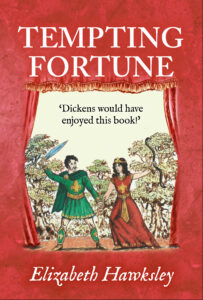
The cover for Elizabeth Hawksley’s Tempting Fortune in e-books by John Hocking based on the original by Michael Thomas
Tempting Fortune is a book very dear to my heart. The main action takes place around Sadler’s Wells Theatre’s innovative 1853 production of Shakespeare’s Midsummer Night’s Dream. The actor manager Samuel Phelps both directed it and played the part of Bottom to great critical acclaim. This is how my novel came about.
I was studying part-time for an MA in Victorian Studies at Birkbeck College. One of the modules was Victorian Theatre and my tutor asked me to do some research into the famed Victorian actor-manager Samuel Phelps (a man I’d never heard of at the time) and present my findings at a seminar. After some frantic initial research, I found myself in the Islington library archives surrounded by shelves of dusty boxes full of theatrical ephemera about Sadler’s Wells Theatre’s 1853 production of A Midsummer Night’s Dream which comprised yellowing newspaper reviews and articles, tatty theatrical posters, and a number of old theatrical books.

Samuel Phelp’s house in Canonbury Square, Islington.
I tracked down other sources, too. The Theatre Museum, then in Covent Garden, had more material, and I discovered that the Folger Shakespeare Library in America had Phelps’ own promptbook for the Dream which contained details of his stage directions together with various theatrical tricks such as making Puck appear and disappear as if by magic.
However, the idea of setting a novel at Sadler’s Wells arrived more slowly. The advance for my first two Elizabeth Hawksleys (Lysander’s Lady and Country Cousin) actually paid for my MA course; I was teaching Creative Writing, as well as GCSE and ‘A’ level English part-time at a College of Further Education so I was fully occupied. Tempting Fortune was to be my 6th book but I didn’t forget my interest in Phelps’ production of The Dream. It didn’t disappear entirely, even while I was writing my third, fourth and fifth Elizabeth Hawksley books – which I did mainly during the summer holidays.
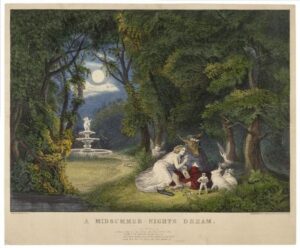
The Athenian wood from Samuel Phelp’s production of ‘A Midsummer Night’s Dream’, Sadler’s Wells Theatre, 1853. Courtesy of the Folger Shakespeare Library
By the time I graduated, I knew exactly how a mid-Victorian theatre like Sadler’s Wells worked; I knew who did what, and was familiar with the most important people who worked there in 1853, like the immensely talented set designer, Frederick Fenton, and ‘Pepper’ Williams, the crusty old Prompt who had a little cubby hole by the theatre door. I knew what they were like as people, and what parts they played in the Dream (Mr Phelps everyone was expected to act, if required).
One day I was looking at the Dream’s cast list on a tattered old poster when the name ‘Sarah Beale’ grabbed my attention – she was one of Hippolyta’s attendants. Sarah Beale would be a good name for a heroine, I thought. Instantly, I could see her: Junoesque but self-conscious about her height. Suppose I made her a talented theatrical costumier who worked with the theatre’s costume designer, Miss Bailey; that should give me plenty of scope.
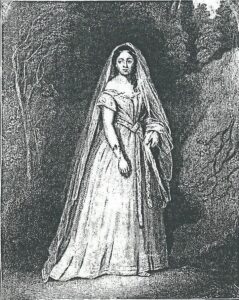
Miss Cooper as Helena (costume designed by Miss Bailey) in Phelp’s 1853 production of ‘A Midsummer Night’s Dream’ at Sadler’s Wells Theatre. Reproduced in ‘The Sketch’ 10th Jan, 1900. Theatre Museum Archive.
As I thought about my newly-emergent heroine, I learnt more about her. She needed problems to overcome: suppose she was illegitimate, and her young mother had died whilst begging in the porch of the nearby St James’s Church in Clerkenwell Green when Sarah was about eight months old.
That would give Sarah a number of things she can’t talk about – her illegitimacy for a start, and the fact that her horrible father thought that she should never have been born. My Sarah needed to develop more self-confidence – especially around men. I’d enjoy writing that!

Actor Manager, Samuel Phelps (1804-1878) photo courtesy of Wikipedia
Sarah’s story would link up with my hero’s, Jack Midwinter – and, at first, that was all I knew about him. (I’d come across the name in a newspaper and thought Wow! What a name for a hero!)
And then, one day in August 1995, I was listening to In the Psychiatrist’s Chair on the radio; it was a programme where the eminent psychiatrist, Dr Anthony Clare, interviewed famous people in depth about their lives. That day, it was the popular conductor, Colin Davis, (1927-2013) who was being interviewed. And I admired Davis’s thrilling conducting.
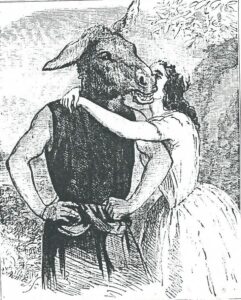
Samuel Phelps as Bottom in Sadler’s Wells Theatre production of ‘A Midsummer Night’s Dream’. Illustrated London News, Nov. 12th 1853
Colin Davis was one of the early 1960s musical whizz-kids, (André Previn was another). As a young man he had acquired a reputation for rebelliousness and a fiery temper, and his application for the post of conductor had been turned down by a number of top British orchestras – when his obvious musical talents should have made him their first choice. My impression of him was that he was an immensely talented man, always jet-setting all over the world conducting famous orchestras. One moment he’d be conducting in New York, the next in Dresden or Munich.
But, as I listened to his conversation with Dr Clare, I learnt that, increasingly, he hadn’t enjoyed the life-style; his marriage was under stress, and, in 1964, it, and his life, fell apart. As he put it: ‘I realized that I didn’t like myself very much.’
He began to understand that what he really wanted was a different sort of life, and, indeed, marriage; one with lots of children (he had two children by his first wife), a proper home life and a wife who wasn’t interested in jet-setting. He got divorced and married a Persian student, Ashraf Naini, known as Shamsi, and they settled down happily with their five children. And his subsequent appointment as chief Conductor of the BBC Symphony Orchestra, (which of course included the Proms) gave his professional life the stability it needed, and he flourished.
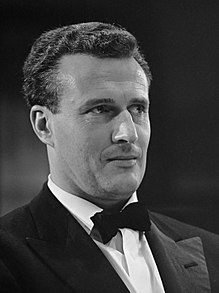
Colin Davis (1927-2013) courtesy of Wikipedia
Something about his story and the way he told it to Dr Clare, stayed with me. I can’t remember now if Colin Davis went to London Zoo, as my Jack does, or if he had a similar Epiphany, but I knew that I’d found the sort of hero my book needed.
My Jack is, like Colin Davis, handsome, wealthy, very attractive to women, and he lives the life of a popular man about town. Then out of the blue, something happens which turns everything upside down. Suddenly, everything he thought he wanted turns to dust. But does he have the courage to break free of his comfortable shackles?

Book cover for the hardback edition of ‘Tempting Fortune’ by Elizabeth Hawksley design: Michael Thomas
Writing Tempting Fortune was a happy experience and I was very lucky that my publisher selected Michael Thomas to design the cover. I wanted a cover which echoed 19th century theatre ‘penny black or tuppence coloured’ prints which were immensely popular at the time. I described what I had in mind: the play was Shakespeare’s A Midsummer Night’s Dream’, my hero and heroine were playing Theseus and Hippolyta’s attendants and I quoted my description of their costumes and the colours. I also described the scenery.
And, to my delight, Michael came up with exactly what I wanted. And 22 years later, he has kindly allowed me to use his original artwork as a basis for the new e-book cover.
I’m thrilled that Tempting Fortune is going into e-books and I hope that it will give pleasure to many readers.
Elizabeth Hawksley
Tempting Fortune comes out with Amazon on Monday 12th April
Please share this page...
I am not at all familiar with A Midsummer Night’s Dream, but it is nice to get a peek behind the scenes of your creative process.
Thank you for your comment, Huon. My mother took me to see A Midsummer Night’s Dream when I was about 14. I laughed so much that I nearly fell off the seat!
Your novel sounds fun, Elizabeth. I have a soft spot for this play, probably because the first performance of it I saw was the Peter Brook production at Stratford in 1970. I was a very young student at the time, but it was totally mind-blowing!
Thank you for your comment, Gail. I, too, saw Peter Brook’s ‘Dream’- thrilling, I agree. Later, I saw his ‘Tempest’ at the Round House – an old railway engine turntable in London where the audience were perched on bits of scaffolding and pushed around by the actors. The actors were all wearing Judo garb. Wacky, but thrilling.
‘Tempting Fortune’ is set around the 19th century equivalent of Brook’s ‘Dream’ – it was the first production to go back to Shakespeare’s original for 250 years and it became the hottest ticket in Town. Of course, the story has other elements: an abandoned orphan, an abduction, a sexy rake who needs to grow up, and a heroine who has to fight her corner. I loved writing it.